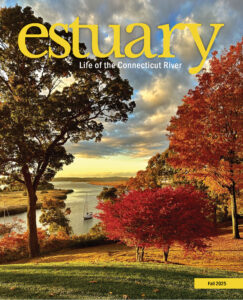 This article appears in the Fall 2025 issue
This article appears in the Fall 2025 issue

It was a veritable Who’s Who of the Connecticut River watershed’s principal stewards last May at a two-day retreat of the Connecticut River Watershed Partnership (CRWP). Led by CRWP’s executive director, Mass Audubon’s Markelle Smith, twenty-seven people spent all or part of the meeting at the Grafton Inn in Grafton, Vermont, discussing past successes, current challenges, and steps to more effective collaboration. Estuary magazine is a member of the CRWP and, along with its parent, The Watershed Fund, supports greater collaboration throughout the watershed.
The group celebrated successes, including greater awareness of watershed issues by state and local agencies and on Capitol Hill; a diverse membership in the partnership; broad participation at CRWP gatherings; and funding for executive management. Participants expressed satisfaction that funds have been raised expressly for the CRWP and congratulated themselves on having endured over a long period of time and accomplishing a great deal along the way through thick and thin.
It was evident, however, that CRWP faces many challenges. Paramount among them are changes in federal funding under the new administration, especially negative changes. Other challenges include the need to increase awareness of the work that CRWP does throughout the watershed; fully funding its executive staff on a more permanent basis; and grappling with the complexity of four state governments (each having different “silos” of responsibilities), several federal agencies, and state chapters of the large national environmental agencies. The group also talked about the need for new ways of thinking about river conservation, for example, the different missions of land conservation and river restoration: both are of equal importance but are represented by very different organizations, missions, and functions.
The retreat yielded a useful compilation of ideas and strategies. A list of twelve ways to be more effective collaborating within the watershed included lobbying for legislation and federal funding; building a consensus of the CRWP’s mission; and expanding the partnership to include watershed industries, tribes, and local governments. Another suggestion was to inventory member capacities and needs. Finally, greater emphasis on educating citizens of the watershed about the river as a resource for biodiversity and culture was recommended.

Image Credit: Frank DiNardi.
Buried in the minutes of the retreat sat this compelling vision for what success would look like: “A bald eagle catching a river herring from a river segment with a restored and healthy population of migratory herring.” The bald eagle—almost extirpated from the watershed just a few decades ago—underscores just how precious and fragile today’s ecology is within the watershed. The river herring suggests that despite the pandora’s box of complexity that goes far beyond the boundaries of the watershed (river herring are imperiled by pernicious overharvesting, much of them caught by accident), it has returned to feed the eagle and avoided being tossed by the hundreds of tons into ocean-going fish meal processors, en route to becoming canned dog food. In short, when bald eagles in the watershed are sustained by an abundance of river herring, we’ll know we’ve succeeded.
For more information about the Connecticut River Watershed Partnership, visit friendsofconte.org.


Dick Shriver
Publisher & Editor
Participants, Connecticut River Watershed Partnership Retreat
May 22 and 23, Grafton, Vermont
Steve Agius, US Fish and Wildlife Service
Bill Ardren, US Fish and Wildlife Service
Brianna Brumbaugh, Keystone Policy Center
Chris Campany, Windham Regional Commission, CRWP Executive Committee
Charles DeCurtis, The Nature Conservancy (NH)
Patty Gambarini, Pioneer Valley Planning Commission
Tom Geser, US Fish and Wildlife Service
Leah Hart, Society for the Protection of New Hampshire Forests
Elizabeth Kaeser, Connecticut River Museum
Jillian Liner, Audubon Vermont, CRWP Executive Committee
Kirsten Martin, University of Saint Joseph
Peg Merrens, Upper Valley Land Trust
Alisha Milardo, Connecticut Audubon Society, CRWP Executive Committee
Lelaina Muth, US Fish and Wildlife Service
Curtis Ogden, Interaction Institute for Social Change
Andrew Petit de Mange, National Park Service
Helen Royal, Keystone Policy Center
Markelle Smith, CRWP Executive Director
Brad Sperber, Keystone Policy Center
Ken Sprankle, US Fish and Wildlife Service
Steph Stroud, National Park Service
Chris Thayer, Appalachian Mountain Club
Rebecca Todd, Connecticut River Conservancy, CRWP Executive Committee
Jodi Valenta, Trust for Public Land
Tom Webler, Social and Environmental Research Institute
Lael Will, Vermont Agency of Natural Resources
Liz Willey, US Fish and Wildlife Service
